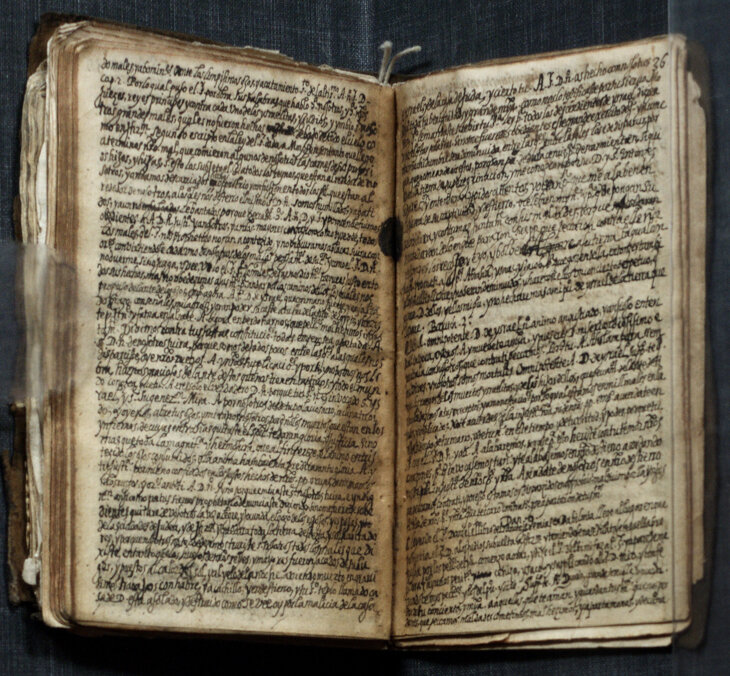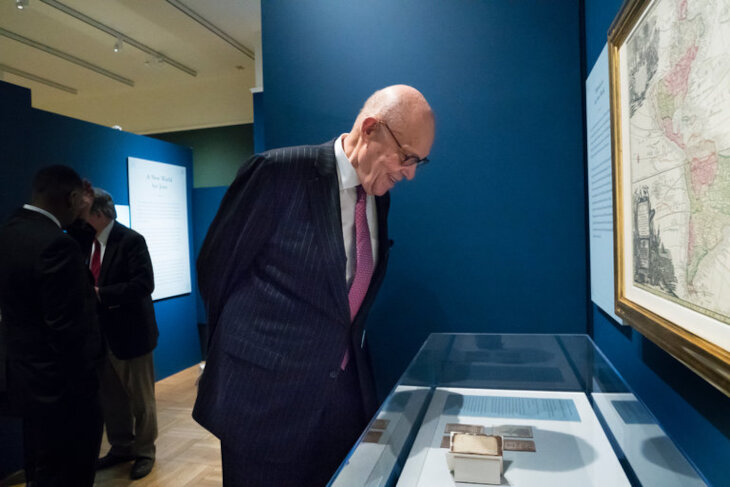 As a Jew, The Meaning of “America First”
As a Jew, The Meaning of “America First”


7 min read
The amazing story of Luis de Carvajal, a secret Jew who was murdered in the 1500s, and the unlikely survival of his handwritten memoirs.
Nearly five hundred years ago, Luis de Rodriguez Carvajal, a secret Jew living in terror of the Spanish Inquisition, penned the following words at great risk to his life: “To practice Judaism is not heresy; it is the will of the Lord our God.”
The Jewish book he secretly wrote has been found and is on display for the first time in decades.
Luis de Rodriguez Carvajal and his family lived in the 1500s in Spain. Judaism had been banned in Spain in 1492 but many Jews, including the Rodriguez family, continued to secretly cling to Jewish faith and rituals, while living publicly as Catholics. The fearsome Spanish Inquisition ruthlessly hunted these secret Jews, torturing and executing anyone suspected of engaging in Jewish rituals.
 Photo of Carvajal Manuscript
Photo of Carvajal Manuscript
In in 1580s, Luis de Rodriguez, his mother, father and siblings were invited to settle in the Nuevo Leon, an area in today’s Mexico governed by Luis’ uncle, Don Luis Carvajal. The family moved, and became close to Carvajal, changing their surname from Rodriguez and publicly embracing their powerful relative’s Catholic faith.
In “New Spain”, Luis de Rodriguez, now de Carvajal “the Younger,” continued to keep his Jewish identity as best he could. On Fridays before Shabbat, Luis’ mother and sisters washed the bed linens and prepared festive food, including a chicken dinner for Friday nights. The entire family wore their best clothes on Saturday, and the women of the household refrained from the sewing that customarily kept them busy (though they made sure to keep their sewing handy in case unexpected visitors dropped by).
For a month, he transmitted his knowledge to Luis, preparing him to be the leader of their circle of secret Jews.
Before Passover, Luis and other secret Jews in their Mexican community would slaughter a lamb, roast it and eat it, trying to recreate, as Luis described, the first Passover feast: “On foot, like people about to set out on a journey, staves in hands and loins girded”. Their community also secretly celebrated the Jewish holidays Purim and Yom Kippur.
In 1585, Luis and his father, Francisco Rodriguez, who worked as barterers and traders, travelled together to Mexico City for business. There, Francisco became gravely ill. Fearing he might never recover, he told his son Luis all he could about their secret Jewish faith. For a month, he transmitted his knowledge to Luis, preparing him to be the leader of their circle of secret Jews. It was an intense time that profoundly changed the course of Luis’ life.
When he returned home, Luis was more committed to his secret faith than ever. He circumcised himself and began to declare his Jewish beliefs publicly. He also encouraged other secret Jews to do the same. Sometime around 1590, Luis and his family were arrested for encouraging Judaism. His mother, Francisca Nunez de Carvajal, was tortured into near madness. The Inquisition authorities later said that under torture she’d implicated her husband and children as secret Jews.
During this time, Luis began writing his memoirs, titled “Memorias”, in tiny script on miniature pages, about four by three inches. In this secret book, Luis seemed to give his imagination free reign, calling himself by a new name that might have had some secret meaning in his community, Joseph Lumbroso.
The book begins: “Saved from terrible dangers by the Lord, I, Joseph Lumbroso of the Hebrew nation…” and goes on to address itself to all “who believe in the Holy of Holies and who hope for great mercies.”
“Memorias” eventually grew to 180 tiny pages penned in an almost impossibly small script. As well as Luis’ memoirs, it included Jewish prayers, the Ten Commandments, and Maimonides’ Thirteen Principles for Faith. Luis painstakingly stitched the book together; its small size implies that it was hidden in a pocket and carried with him.
Luis jumped out of a window to escape his horrific torture. Somehow, he survived.
Luis was briefly released from prison. Some modern scholars think this was so the Inquisition authorities could track his activities. Tragically, in 1596, he was arrested, along with his mother, four sisters, brother and a number of other Jews, and they were tortured. At one point, Luis was shown his manuscript and acknowledged that it was his. He was tortured so severely that he jumped out of a window to escape the agony. Somehow, he survived.
Finally, after weeks of gruesome torture and imprisonment, nine of the Jews were put to death in a mass public burning for the “crime” of being Jewish. The victims included Luis’ mother, his sisters Isabel, Catalina and Leonor, and Luis himself. Luis was 30 years old. (Five years later, another sister, Mariana, was publicly burned at the stake.)
Miraculously, Luis’ secret book somehow survived. Tattered, well-worn, its pages apparently turned over and over by an unknown number of readers through the years, “Memorias” eventually was placed in Mexico’s National Archives, where it remained for hundreds of years, until vanishing in 1932.
For eight decades, “Memorias” remained lost. In Dec. 2015, it suddenly resurfaced in a London auction house.
No one knows who took it but modern scholars have a theory. At the time, at least three academics were researching the de Carvajal family at the National Archives. One historian accused a rival, a Jewish academic from Northwestern University near Chicago, of stealing the book. The Jewish academic spent approximately three months in jail for the theft but no evidence implicated him in the crime. It’s thought that the academic who accused him was the true thief.
For eight decades, “Memorias” remained lost. Then, in December 2015, it suddenly resurfaced in a London auction house. Bloomsbury Auctions didn’t recognize the book’s importance, blandly describing it in their auction listings as “small devotional manuscripts” and pricing it at $1,500, a small fraction of the work’s actual value.
In response to questioning about the document’s whereabouts, all the auctioneers would reveal is that it came “from the library of a Michigan family...in their possession for several decades.” Timothy Bolton, a specialist at the Bloomsbury Auctions, justified their decision to keep the previous owners’ identities private saying “one of the fundamental cornerstones of the auction world is our client’s privacy.”
“Memorias” was bought in London, then promptly listed for sale in New York. There, Leonard Milberg, a prominent 85-year-old New York collector, saw it and recognized its importance. He consulted with experts who agreed that the tiny book was Luis de Carvajal’s, and also cautioned Mr. Milberg that it had been stolen. “It is the earliest surviving personal narrative by a New World Jew...and the earliest surviving worship manuscript and account of coming to the New World,” explains scholar David Szewczyk.
 Mr. Milberg viewing Luis de Carvajal’s manuscript at the New-York Historical Society.
Mr. Milberg viewing Luis de Carvajal’s manuscript at the New-York Historical Society.
Credit Sara Krulwich/The New York Times
Mr. Milberg got in touch with Diego Gomez Pickering, the Consul General of Mexico in New York, and arranged to repatriate the book, paying tens of thousands of dollars of his own money to acquire the book so that it could be returned to Mexico’s National Archives. He had only two requests. One was that before its repatriation, “Memorias” would be on view in New York, on display at the New York Historical Society.
Mr. Milberg also asked that digital copies of Luis de Carvajal’s book be made for Princeton University and for Manhattan’s Spanish-Portuguese Synagogue. This, Mr. Milberg explained, is a way of “getting back at anti-Semitism. I wanted to show that Jews were part of the fabric of life in the New World,” he explained. “This book was written before the Pilgrims arrived.”

You can see the entire manuscript here: https://mexicangenealogy.com/the-manuscripts-of-luis-de-carvajal/
Just a little story: I was in Faro in southern Spain years ago at a cafe. A man walked by among all the others in town an I don't know why, but I thought to myself "that guy's Jewish". I dismissed the thought and about a half hour later while walking on the street, someone tapped me on the shoulder. I turned around and it was that same person and he asked me, in Spanish, "Are you Jewish?"
A powerful story. Yet restrained and moving.
Where can this book be seen? The photograph shows Mr. Milberg looking at it at the New York Historical Society Library, but there is no date as to when this was. Is it there, or in Mexico?
Todah Rabah! I had no idea that Mexico also participated in the Inquisition and persecution of the Jewish people! This document should be given to one of the Holocaust Museums.
The Spanish Inquisition took place in both Spain and Portugal as well their colonies in the new world such as Mexico and Brazil. But we are still here we have outlasted not only the Inquisition but the Egyptians, Babylonians, Greeks, Romans, Nazis, and soon Hamas and their supporters.
Now led by a atheist Marxist Jew, Mexico leads world to crucify State of Israel.
How can we view/read the digital manuscript?
Very nice article.
IMHO it should not have gone back to the government of Mexico, as no doubt it was originally stolen from Luis's family and ended up as government property. Rather it should have been returned to the rightful owners, the Carvajals who have remained loyal to Luis's beliefs.
Would you kindly provide the date this article appeared in Aish?
Luis de Carvajal "el mozo" (the young one) circumcised himself when he read in "the Old Testament" that a Jew who was not circumcised would be cut off from his People (karet). He took a pair of old scissors from the kitchen and went down to the river to circumcise himself. (Reid Heller, Dallas, TX).
I grew up with Carvajales in Ysleta, Texas. I am convinced we (all these families in the Catholic Parish surrounding the old Ysleta Mission) are from secret-Jewish descent: from the Conversos of Spain.
Take DNA tests. I've read My Heritage is the best company for discovering Jewish DNA.
Yes, take a DNA test. When I was in Spain I had a weird feeling of kinship wherever I looked. So many appeared. ‘ Jewish ‘ DNA does not lie.
Gracias Vera!
Hi Chana. I wonder if your family comes from Donna Gracia Nasi-Mendes, and very famous Jewish heroine of the Inquisition Era. She helped many secret Jews escape. You can see more in this aish.com article https://aish.com/dona-gracia-nasi-the-spanish-inquisitions-underground-railroad/?utm_source=googlegrants&utm_medium=cpc&utm_campaign=19561819333&utm_term=&gad_source=1&gclid=Cj0KCQjwj9-zBhDyARIsAERjds3Zv3J-_g1r15CQqrm7CN56E7a3LXxYQ9XQaFZy9Ymn2DePW9ef0SwaAtp-EALw_wcB